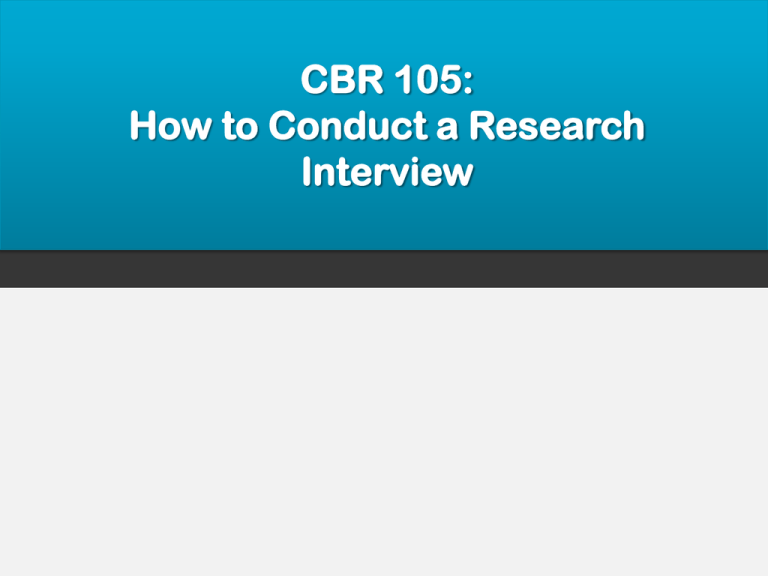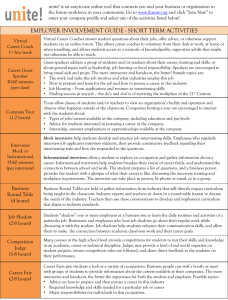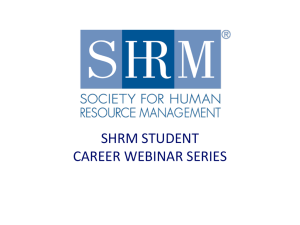Presentation
advertisement

CBR 105: How to Conduct a Research Interview Objectives Upon completion of this workshop participants will be able to: • List the key principles associated with CBR • Recognize cultural considerations critical to CBR interviewing • Describe the interview planning process • Differentiate b/w qualitative and quantitative interviews • Design quantitative and qualitative interview guides • Apply good listening skills and best practices for good interviewing practices. 2 Agenda 1. Unique qualities of CBR research; culturally sensitive interviewing 2. Interview planning process 3. Choosing between quantitative and qualitative interviewing; preparing the questions 4. Listening skills 5. Mock interviews 6. Thinking through potential issues 3 Introductions and Opening Activity This workshop is about interviewing, we will get to know each other by interviewing one another • In 1 minute jot down a few questions to ask your partner • Then, you will each have 2 minutes to interview your partner • After the interviews are completed, everyone will take a turn introducing their partner to the group 4 Debriefing the Activity What did you notice about what types of questions people asked? How did you decide what questions to ask your partner? Which questions were most helpful to us as a group in getting to know each other? How did it feel to be interviewed? What worked and what didn’t (aside from the lack of time)? What can we learn about interviewing for research from this exercise? 5 1. Interviewing for CBR 1. What do you think is unique about interviewing for CBR? 2. How do we define CBR? 6 Definition of CBR CBR is a: “...collaborative approach to research that equitably involves all partners in the research process and recognizes the unique strengths that each brings. CBPR begins with a research topic of importance to the community with the aim of combining knowledge and action for social change to improve community health and eliminate health disparities” (W. K. Kellogg Community Health Scholars Program , as cited in Minkler & Wallerstein, 2003) 7 Principles of CBR community relevance ethical review capacity building CBR social action outcomes rigorous methods collaborative partnerships 8 Considerations for Cross-cultural Interviewing Common problems associated with cross-cultural interviewing include: Researchers making false assumptions Researchers perceiving difference as odd This can misdirect: The research interview The nature of the data The interpretations 9 Insider / Outsider Issues When an interviewer and interviewee do not share a common frame of reference there can be issues of: • Physical access • Social access (how much the interviewee shares) • Meaning-making These issues can exist even when the interviewer is an ‘insider’. (Shah, 2003) **EXAMPLES???** 10 Tips for Culturally Sensitive Interviewing • Provide cultural sensitivity training for researchers on the interviewees’ beliefs, values, behaviors, and communication styles (Schaller, Parker, and Garcia, 1998). • Involve community members as much as possible in the interviewing process to ensure relevant questions and approaches (Padilla and Lindhom, 1995). • When possible, match the researchers to participants from a cultural perspective and form cross-cultural research terms (Shah, 2003). 11 Exercise 1 1. Working in small groups describe the communities you each work with 2. Pick one community and make a list of beliefs, behaviours, and communication styles characteristic of the group that would be helpful for interviewers to know about 3. Be prepared to present your results to the group Watch out for stereotypes! 12 2. Interview Planning Process • Determining a focus. – What do you want to know about? Why? • What have others done? • How much time/resources do you have? • How will you reach potential participants? • What permission(s) do you need? 13 What is Your Focus? • Why do you want to study what you want to study? • What is your rationale? • What do you want your research to achieve? • What are the ‘research goals’? 14 What have Others Done? • How have others asked similar types of questions? (check the literature, colleagues, peers) • Can you use or adapt a pre-existing instrument to meet your needs? 15 15 How Much Time and Resources do You Have? Time-line, deadlines Resources: Dollars # and type of interviewers, training and support Honoraria for participants, peer interviewers Space Taping, tapes and transcription Software, computer for analysis Translation/interpretation 16 How Will You Reach Potential Participants? • Would in-person interviews be best or would phone or email work better? • Is a mailed questionnaire possible or necessary? • If in-person, where would be safe and private? Could you find a room/space close by? • What style of interaction will be most effective? 17 Permissions Community protocol around interviewing What doesn’t this group like? What might they react to? Agency protocol ED, Board, research committee requirements Funder Protocol: what do they ask for? 18 Permissions Research ethics board (REB) Formal ethics proposal Has to be done well before the interviews start Need to submit copies of your interview guides 19 3. Quantitative vs. Qualitative Interviews What is the difference between qualitative and quantitative interviews? 20 Quantitative Interview • Closed questions • Aiming for clear answers (that can be quantified) • Often focused on the descriptors/variables and their relationship – e.g. Number of days in hospital 21 The Checklist Please select all of the ice cream flavours that you have eaten in the last month? Chocolate Vanilla Strawberry Banana Other: __________ (please specify) 22 Ranking Order the following ice cream flavours by preference (where 1=your favourite & 4 = your least favourite)? Chocolate Vanilla Strawberry Banana ___ ___ ___ ___ 23 Likert Scale Please rate the degree to which you agree/disagree with the following statements: 1) Ice cream is my favourite dessert. 1 Strongly agree 2 Agree 3 Neutral 4 Disagree 5 Strongly disagree 2) Ice cream is a healthy dessert option. 1 Strongly agree 2 Agree 3 Neutral 4 Disagree 5 Strongly disagree 24 Qualitative interviews • • • • • • In-depth (an hour +) Personal, challenging and time-consuming Relatively few questions, often open ended Structured, semi-structured, or unstructured. A way of finding out what others feel, experience, understand Often taped and transcribed 25 Sample Qualitative Interview Guide • Introduction, thank you’s, confidentiality, taping • Why are you participating in this research study? • Please describe what kinds of supports and services you’ve used in the past? • If someone were to ask you to explain cognitive therapy, what would you say? • Could you describe any turning points or key moments in the process? • What is an image or symbol to describe your experience of cognitive group therapy ? • Is there anything else I should know? 26 Tips for Both Types of Interview Guides Keep the number of questions to a reasonable limit so as not to overwhelm. Pilot your guide and test it first. Be open to redesigning the guide if it’s not working. Consider social desirability bias. 27 Exercise 2 – Preparing & Discussing Different Types of Interview Questions In small groups, choose a topic related to one of the interviewee populations you brainstormed characteristics for earlier. Keep in mind cultural sensitivity issues. Team 1: Develop a quantitative interview guide with 10 questions. Team 2: Develop a qualitative interview guide with at least 7 questions. Once completed, regroup, share your questions, and give each other feedback. 28 4. Listening Skills 29 Acquiring Critical Listening Skills • Listening takes up half of all our waking time. • Requires effort and skill, but suffers from the effects of a fast paced, impatient, advertising driven ‘Western’ world. • Not just ‘hearing’ (physiological): complex psychological, cognitive and cultural dimensions. • Includes perception, organization, remembering and responding. • Responding is often overlooked, but it will change a dialogue or dynamic. 30 Barriers to Listening Obstacles to listening are both external (noise) and internal (preoccupation, prejudgment, lack of effort) Nonlistening: Pseudolistening Selective listening Literal listening Ambushing 31 Central Components of Listening 1. Start by being mindful: • being present, in the moment and paying close attention 2. Ask questions .. seek to understand 3. Paraphrase and clarify. Goal is understanding. 32 Central Components of Listening Enhanced by practice of FELOR F=face your speaker E=make eye contact (if appropriate) L=lean in O=stay open R=relax 33 Exercise 3: Partner Activity - Listening Practice 1. Work in groups of 3 (Listener, Talker and Observer) 2. Decide who will listen and who will speak first. 3. The speaker will talk for 2 minutes about something important to him/her. 4. Listener will listen actively and use the techniques we talked about to show he/she is listening. 5. After 2 minutes – listener is to restate the key points back to the talker. Talker validates information/ 6. Observer is to share what they noted during the exchange 7. Rotate until each team member has taken on each role 34 5. Mock interviews 35 Exercise 4: Mock Interview Guidelines 1. Interviewers and interviewees stay in character, keeping in mind all skills learned from the day • cultural sensitivity issues, listening skills 2. Observers take note of and be prepared to give feedback on: Verbal and non-verbal communication (FELOR, cultural sensitivity) Quality of interview questions 36 Exercise 4: Debrief of Interviews 1. Interviewers reflect: • How did you feel? • What did you do well? • What could you have done better? 2. Interviewees reflect: How did you feel? 3. Observers provide feedback and comments on: What was done well Suggestions for improvement 4. Interviewers respond. 37 6. Issues in Interviewing 38 Some Key Issues • • • • • Breach of confidentiality Misinformation Safety Inappropriate/odd behaviour Compensation Others? 39 Objectives Having completed this workshop participants should now be able to: • List the key principles associated with CBR • Recognize cultural considerations critical to CBR interviewing • Describe the interview planning process • Differentiate b/w qualitative and quantitative interviews • Design quantitative and qualitative interview guides • Apply good listening skills and best practices for good interviewing practices. 40 Workshop Evaluation Your feedback is extremely important! Please complete the workshop evaluation…. Thank you! 41 CBR 105: How to Conduct a Research Interview







